The National Gallery’s latest Renaissance instalment, Veronese: Magnificence in Renaissance Venice, turns the gallery’s walls into a colourful theatre of Venetian style and drama.
Veronese loved clothes. So much is evident from the canvases hanging in the upper rooms of the National Gallery, where Venetian noblewomen rustle against saints, gods and Roman soldiers in a parade of damask and taffeta. Veronese: Magnificence in Renaissance Venice, which took five years to organise and brings together fifty of the painter’s works from across Europe and the United States, has transformed the walls of the gallery into a sixteenth century catwalk, with the artist’s models cropping up again and again, clad in one lavish item of fine couture after another.
This is the first show in the UK devoted entirely to Veronese, which seems surprising given the artist’s stature as one of the foremost painters of the Venetian Renaissance, alongside Bellini, Giorgione, Titian and Tintoretto. But if Veronese’s reputation was big during the sixteenth century and in the centuries that followed, so were many of his canvases, making the staging of any exhibition a major logistical undertaking. A rumour that someone else in London was planning a show, a bout of jealousy on the part of Nicholas Penny – then newly appointed as Director of the National Gallery – and some hefty postage and packaging, however, have resulted in today’s display.
When it comes to Paolo Veronese, born in Verona in 1528, big does indeed mean big, and the National Gallery can be forgiven for not attempting to import some of the canvases which fall on the larger end of the artist’s spectrum. The Louvre’s Feast in the House of Levi (1573), for example, is 5.6 by 12.8 metres, which is bigger than a double-decker bus. In fact the largest of the painter’s works, as well as many of his slightly smaller pieces, some of which have been shipped to Trafalgar Square, were painted as decorations. Had Veronese lived and worked anywhere other than Venice, these scenes would have been executed as frescoes, stuck forever to the wall on which they were painted. The inevitable damp of a city built on water, however, meant that when it came to interiors, mural paintings were out, and large canvases were in. And, in the scheme of things, this has rendered Veronese relatively transportable.
During the course of his career, Veronese turned his hand to each of the genres typical of a sixteenth century Italian painter, and enormous banqueting scenes aside, these form the basis of the current show. And whether it is a portrait, altarpiece, allegory or decorative biblical scene, Veronese’s awareness of where the picture will hang and what purpose it will serve, is acute. For Renaissance genius or not, Veronese was ultimately a painter decorator, commissioned by his patrons to tart up their homes and spruce up their churches. The four allegorical panels which belong to the National Gallery, and are hung for the exhibition around the Met’s Mars and Venus United by Love (1575-80) on the walls of an octagonal room, were originally intended for a ceiling. Perhaps it was a step too far for the curators to haul the canvases up and fix them to the gallery’s roof, but if viewed from this vantage point, the angled architecture and diagonal composition, not to mention cupid and his missing feet, can be understood.
Veronese’s The Family of Darius (1565-7), which was bought by the National Gallery’s first director, Sir Charles Eastlake in 1857 for £13,650 (the equivalent of over £1.3 million), also shows the artist’s perception as a decorator. Although filled with figures and detail, this is a scene which takes place in its own space: there are no intruders into the real world here, no artistic effects forcing the eye on to this classical stage. It was a picture intended as a backdrop, which would be passed by and glanced at time and time again by the noble family for whom it was commissioned. And for this reason, the artist has chosen his narrative with care. Who, after all, wants to see Darius’ corpse each time they go into the salon for a coffee break?
Dead bodies, no, but drama? Of this there is plenty. A common observation made is Veronese’s desire to amuse his viewers: an entertainer, rather than an edifier in the words of Dr Penny. And although in the artist’s religious altarpieces and church panels, he steers clear of monkeys, dwarfs and halberdiers, he does not overload the worshipper with intense emotion. The Martyrdom of Saint George, a vast altarpiece which comes to London from Verona where it has been since its last field trip with Napoleon, may show the saint on the verge of execution, but there is little tragedy to the scene. And perhaps tragedy is unnecessary here, for Veronese has chosen to depict the moment when George sees the Virgin, Christ child and accompanying saints tumbling out of the sky to save him. “I’m going to be fine”, he seems to be thinking. His captors, however, busy persuading the saint to slay some Christians, have not noticed what’s going on above, while the executioner behind him (a typical bit-part thug and not someone you would like to meet on a dark canal), prepares for the slaughter. In the Mystic Marriage of Saint Catherine (1565-70), usually in Venice’s Accademia, there is a jolly party, yards of glorious fabric, a massive composite column and a pair of chattering angels. Mysticism however? Not much.
Such is Veronese’s dramatic ability, it is as if, in many of the works, someone has pressed pause. The painter, with his large canvases and architectural settings in which numerous cleverly stage-managed figures act out their scenes, creates a static theatre. And in doing so, the viewer finds himself in the centre of a peculiar juxtaposition of, on the one hand, action, noise and performance, and on the other, motionlessness and silence. Darius’ mother is freeze-framed at the most embarrassing moment of her life when she pleads for mercy to the wrong guy, and St Nicholas, in the gallery’s own The Consecration of Saint Nicholas (1562), on the brink of his surprise consecration, has been switched off at the mains.
It is colour, however, which is this artist’s leitmotif; and surrounded by fifty of his works at once, the effect is intoxicating. That said, not every one of the pieces included in this exhibition is on a par with another, whatever the curators have said about their rigorous selection criteria. The Rest on the Flight of Egypt (1570-72), for example, on loan from The State Art Museum of Florida, is of dubious quality, both in its condition, and its composition (take a look at the donkey’s head which appears to be being sliced off by the tree trunk). But for the most part, this is an exhibition which shows Veronese at his Technicolor best. In 1660, 70 years after Veronese had died, the Italian critic Marco Boschini wrote, “one can say that the painter, to achieve such effects, had melted together gold, pearls, and rubies, emeralds and sapphires finer than fine, and the purest and most perfect diamonds”. As a painter in Venice, with its exotic mercantile traffic, Veronese made use of the premium ingredients which were available, as did the city’s glass blowers and textile dyers. Although not every palette mix has endured the passing of time, – the blue draperies in The Family of Darius and The Consecration of Nicholas for example, based on cobalt rather than indigo and ultramarine, are less well preserved – visitors can lose themselves in the orchestra of colours on show. And Veronese’s colours do not stand alone in isolated passages; they are balanced and intermingled to form a harmony, uniting his vast canvases into manageable composites.
In a small room near the beginning of the exhibition are three portraits, two unidentified gentlemen and the “Bella Nani”. The chaps wears black and, at first glance, the colour schemes, for Veronese, seem uncharacteristically muted. But look a little deeper and you will see that here are examples of Veronese-the-colourist at his best: these are no ordinary blacks, these are Manet blacks, rich, deep and varied to a point where it is difficult to tear the eyes away. “Bella Nani” has not done badly herself, with her heavy velvet gown and gold trimmings, although she hardly seems to know it as she toys nervously with her veil. We do not know who she was and so cannot say whether she had any right to such diffidence; but if she found the experience of sitting for her portrait uncomfortable, Veronese revelled in the opportunity to paint such fabric, jewellery and hair. Whether or not she was a natural blonde (did they do highlights in sixteenth century Venice?), this was a good hair day for Bella Nani, preserved for time immemorial on the canvas.
The National Gallery’s Veronese blockbuster – and it seems fair to give it that label – is not to be missed. Yes, there will be plenty of people (although not as many as for Leonardo in 2011), and no, you will not be able to stand in front of The Family of Darius for an hour in isolated bliss, as Henry James could 140 years ago. But, if your timing is right, this is a show in which to lose yourself, a show which under the surface represents five years of hard slog, but which does not suffer from curatorial excess. There are no captions next to the paintings to distract the eye (if you want information, you can read the booklet, which includes a short paragraph on each work), minimal writing on the walls, and, unlike the Leonardo, there is very little glass in front of the canvases. Unsurprisingly, the superlatives have been rolled out by critics, “if you see one show this year”, “captures the very essence”, “an astonishing achievement”, and so on; but if I scroll up, I will no doubt find a decent quota of my own gush. It is hard to avoid.
In the final room of the exhibition devoted to the painter’s last years, hangs Lucretia (1580-85), on loan from Vienna’s Kunsthistorisches Museum. The wife of a Roman governor, she was raped by the son of the King of Rome; upon revealing the attack to her father and husband and overcome with shame, Lucretia stabs herself. This is the moment we see in the Vienna painting: despoiled, dishonoured and on the verge of suicide, Lucretia reaches for her sword. But as she does so, she is draped in heavy green and gold taffeta, laden with jewellery, and has not a hair out of place. How very Veronese.
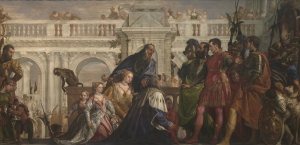

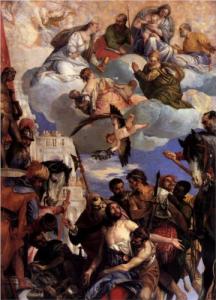
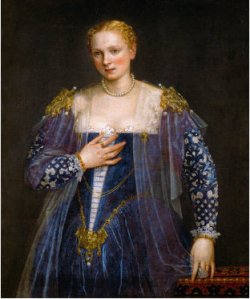
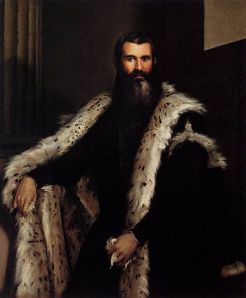
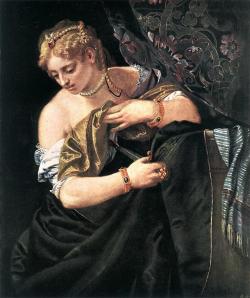

Thank you for such an inspiring review. A breath of fresh air. Currently reading up with the exhibition book, and going tomorrow, 10am. Can’t wait. 🙂
LikeLiked by 1 person
Thanks Mike591 – enjoy the show (and well worth reading up before!).
LikeLike
Thank you for this very interesting review. I’m gong to see this next week and wonder if I shall find anything else to say!
LikeLiked by 1 person
Thanks James – will be very interested to hear what you think… I hardly scratched the surface. Some people have been a bit snooty because Veronese isn’t Titian, but I think that misses the point. Enjoy!
LikeLike
What a lovely review – enough to make me want to go and see for myself and feel a little knowledgeable, but not so much information that when I got there I would feel I’d seen it all already.
LikeLike
Well, I went last Sunday, having done a fair amount of reading up. Better than I expected, and not overcrowded; at least not when I went at 10am. Most of the paintings were a joy to look at. Five or six I thought were breathtakingly beautiful – Adoration of the Kings (NG), Portrait of a Gentleman (1555), Bella Nani, Mystic Marriage of St. Catherine, Family of Darius, Lucretia. A few left me cold and/or amused; Mary Mag in the Wilderness, and (as mentioned above) Rest on the Flight to Egypt.
What also struck me was this: I tend to read the reviews before I see an exhibition. All the normal suspects, Jones, Sooke, Cummings, Waldemar etc., but they never coincide with what I’ve actually felt about the paintings (Waldemar is probably the exception), especially the modern art reviews. I have put this down to my general ignorance, but Alison’s review was spot on, for me at least.
Anyway, I’m all Renaissanced-out, having seen Strange Beauty and spent a lot of time wandering around the permanent paintings in the NG, so looking forward to some more recent stuff! Presumably you will be reviewing the Matisse soon? And I am really looking forward to this: http://dulwichpicturegallery.org.uk/exhibitions/coming_soon/art_and_life.aspx
Sorry about the rambling post, and thanks again for your review.
Mike.
LikeLike
Thanks! So glad you enjoyed it, and that you thought the review not too wide of the mark… it’s a worry, when you’re just starting out, that no one will read you at all, let alone write positive comments.
Definitely going to be covering Matisse, and the Dulwich exhibition does look good – one of my favourite galleries, so I don’t need much excuse to head down there.
Thanks again.
LikeLike
Simply I love all the paintings.
What a great artist.
I had a pleasure of been in beautiful Venice and look at some of gallery’s and appreciate the painting’s , from famous artists to the more amble artists in the streets but you can see the talented and beauty of the city in there paintings, all in all Venice his Magic.
LikeLiked by 1 person
Pingback: THE PROBLEM WITH VERONESE AT THE NATIONAL GALLERY AND ART JOURNALISM | TABOOFART.COM
Pingback: Bricks, Mortar and Paint – Building the Picture: Architecture in Italian Renaisssance Painting | Artseer
Pingback: Warts and All: Giovanni Battista Moroni | Artseer